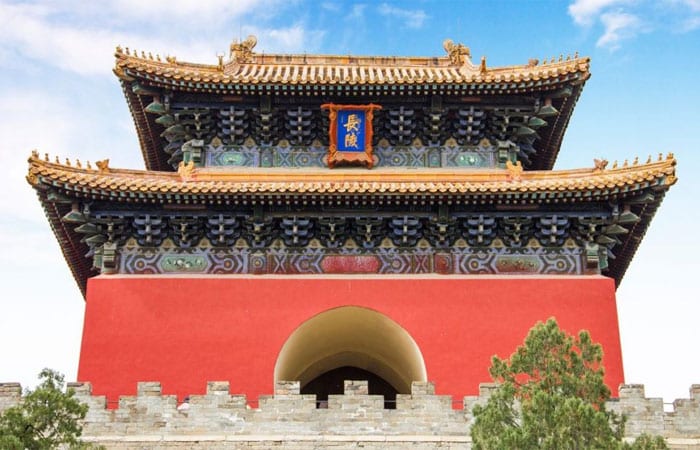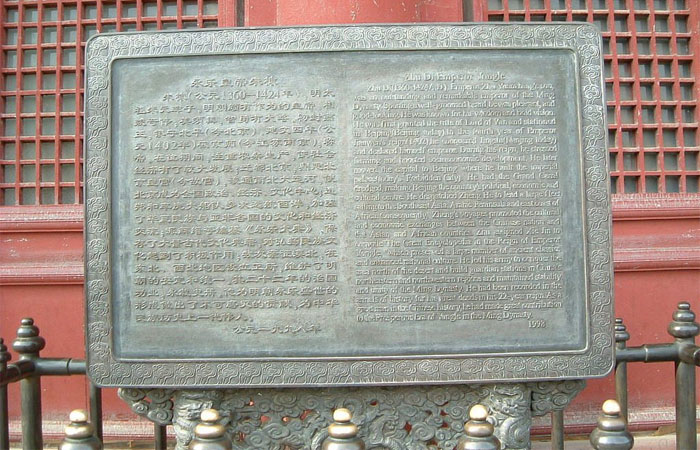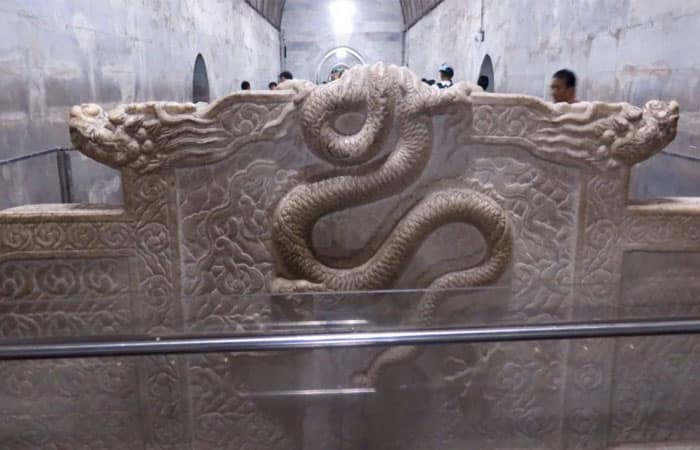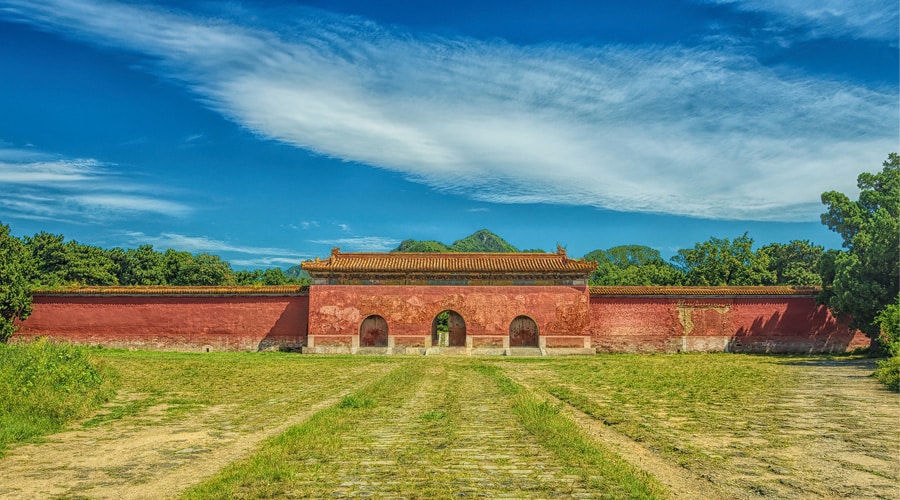Ming Tombs Scenic Area is located at the foot of Tianshou Mountain, about 50 km away from northwest of Beijing. It is also known as the Thirteen Tombs of the Ming Dynasty where the mausoleums of the Ming Dynasty’s (1368-1644) thirteen emperors are located.
History of Ming tombs
It was the first emperor of the Ming Dynasty, Zhu Di, who initially built his Changling Tomb here in 1409. His succeeding twelve emperors then ordered their resting places to be built around Changling in the next 230 years of their reign. The whole area covers more than 120 square km or 46.3 square miles. It is considered the most well-preserved mausoleum location with the most emperors buried.

The Construction of Mausoleums in Ming Tombs
Each mausoleum in the Ming Tombs Scenic Area has its specific autonomous unit. The design and arrangement of all the 13 mausoleums are very alike, though they differ in size and structural complexity. Each one of them was constructed in a region at the foot of the mountain and the distances between them range from 0.5 km to 8 km.
The tombs form a shape of a fan as they stretch out on the 2 sides of Changling Tomb, except for the Siling Tomb that is sitting in the southwest separately. They really pursue an outstanding situation of ‘made by God’ which also reflect the philosophy ‘the unity of heaven and humanity’. The Ming Tombs certainly symbolize the richness of traditional Chinese culture.
The Four Sections
Today, only four Sections (3 of which are tombs) are open to the public in Ming tombs scientific area called the Changling Tomb, Dingling Tomb, Zhaoling Tomb, and the Sacred Way.
The other 10 Ming Tombs that are not open to the public are:
- Yongling Tomb – where Ming Dynasty’s 11th Emperor, Zhu Houcong, and his 3 empresses are buried.
- Xianling Tomb – where Ming Dynasty’s 4th Emperor, Zhu Gaochi, and Empress Zhang are buried
- Qingling Tomb – where Ming Dynasty’s 14th Emperor, Zhu Changluo, and his 3 empresses are buried.
- Maoling Tomb – where Ming Dynasty’s 8th Emperor, Zhu Jianshen, and his 3 empresses are buried.
- Kangling Tomb – where Ming Dynasty’s 10th Emperor, Zhu Houzhao, and Empress Xia are buried.
- Jingling Tomb – where Ming Dynasty’s 5th Emperor, Zhu Zhanji, and Empress Sun are buried.
- Tailing Tomb – where Ming Dynasty’s 9th Emperor, Zhu Youtang, and Empress Zhang are buried.
- Deling Tomb – where Ming Dynasty’s 15th Emperor, Zhu Youxiao, and Empress Zhang are buried.
- Yuling Tomb – where Ming Dynasty’s 6th Emperor, Zhu Qizhen, and his 2 empresses are buried.
- Siling Tomb – – where Ming Dynasty’s 16th and last Emperor, Zhu Youjian, and his Empress Zhou and Concubine Tian are buried.
Sacred Way
Located in front of royal graveyards, the Sacred Way or Divine Road means the road, which leads to heaven. Since the Emperor is known as the Son of Heaven, who came down from Heaven to serve his country through the Sacred Way, his most deserved return to heaven is also through this road.
The Sacred Way usually has stone statues lined up on its side. The statues often include twelve human figures composed of a general, civil officials, and meritorious officials as well as 24 animals.
The Sacred Way of Ming Tombs is one of the most complete and well-preserved in the country. It begins with an enormous stone memorial archway that lies in front of the area. Constructed in 1540, this archway is the oldest and the largest stone archway that exists in China today.
The Animals
These animals include a lion, camel, elephant, Xie Zhi (a mythological unicorn), the 4 divine animals (qilin, dragon, phoenix, tortoise), and horse. One pair of each animal is standing while another pair is squatting.
The Lion
The lion signifies great solemnity because it is ferocious.
The Camel and Elephant
Camel and elephant symbolize the massiveness of the territory controlled by the court since these animals are normally used as dependable transport in desert and tropics.
The Xie Zhi
Xie Zhi was chosen to shoo away the evil spirits since it is believed to own the sixth sense to tell what’s right and wrong. If two men would fight, a Xie Zhi can kill the bad one.
The Qilin
Qilin, which is a symbol of fortune, is also placed on two sides.
The Horse
The horse, which is considered the emperor’s mount, is certainly indispensable.
All these animals are believed to change guard at midnight.
Shengong Shengde Stele Pavilion
Going farther in the Sacred Way, you can already see the Shengong Shengde Stele Pavilion. Inside such pavilion, there is a 50-ton tortoise that carries a stone tablet. At each corner of the stele pavilion, there is a white marble Huabiao or an ornamental pillar.
A mythical beast is located on top of each pillar that faces either outward or inward. Such positions are to express a hope that the emperor will not cling to the palace or forget to return to it to handle the affairs of the state.
Roof Pillars
The two Roof Pillars are located on each side of the road. Their surfaces are engraved with the cloud design and their tops have a rounded cylinder shape. After the 18 life-sized pairs of stone statues, which were all sculpted out of whole stones, the gate named Dragon and Phoenix Gate appears.
The Sacred Way was initially constructed to lead to the Changling mausoleum. During the time, 12 more mausoleums were built.
Changling Tomb
This is the tomb of the Ming Dynasty’s 3rd Emperor, Zhu Di, and his Empress Xu. Among the sixteen rulers of the Ming Dynasty, Emperor Zhu Di, who is also known as the Emperor Yongle, contributed the most to the country and had the greatest impact on history. The Ming Dynasty reached its peak during his reign. He built the Changling Tomb in 1409, which became the biggest and best-preserved of all the thirteen tombs even if it was constructed first.
This scenic destination with grand ancient architecture covers a total area of 120 square meters in Ming Tombs. Its design in front is shaped like a square and its back is round in shape. The front area is divided into three linking courtyards.

The First Courtyard
When you approach the Changling Tomb, firstly, you will find its gate which is an Alhambresque one. Its rafters and arches are all made of colored glaze. It also has three small red doors underneath. Inside the gate, there is a courtyard where a well-reserved stele pavilion is situated.
The Second Courtyard
After the stele pavilion courtyard, you can find the second courtyard, which is probably the most stunning and attractive part of the tomb. The gate to the second courtyard is called the Blessing and Grace Gate or Ling’en Gate. It has a width of 31 meters, a depth of 14 meters, and a height of 15 meters.
At the corners of the steps and below the railings, there are stone drainages shaped like a dragon head. There are stone carvings on the stone road in between each step and its lower part is a surging sea wherein you can see mountains standing and leaping out seahorses. On the upper part, two forceful dragons are flying up and down to chase the fire beads.
Blessing and Grace Palace or Ling’en Palace
On top of the steps, the main building of the Changling Tomb existed, which is called the Blessing and Grace Palace or Ling’en Palace. It is the area used for offering sacrifices for the Emperor and the Empress. It is a very unique tomb palace and considered the best-preserved in the country. The huge camphor wood palace is perhaps the most exquisite relic of ancient China’s wooden architecture.
Its area covers a total of 2,000 square meters and it was constructed on a 3-story-high platform of white marble. Its ceiling is painted colorfully and sustained by 16 solid camphor posts. The floor, on the other hand, is covered with golden bricks. The palace’s hall measures 67 meters wide and 29 meters deep. The life-sized bronze statue of the Emperor sits on the throne that is designed with nine dragons.
The most important feature of the palace is that most of the objects and photos exhibited here reveal the great accomplishments of Emperor Zhu Di. Some of the items here are very rare and priceless, like the portrait of the Emperor, portrait of Emperor Xu, the Yongle Encyclopedia as well as the pictures depicting the Emperor’s achievements such as moving the capital of the country to Beijing and building the Forbidden City.
It has brought scholars together to compile the Yongle Encyclopedia, as well as sending off Zheng He to sail the Atlantic. There are also hundreds of archeological relics of the underground palace.
The Third Courtyard
In the third courtyard, there are a few old structures like the 2-stone archway doors named Lingxing Gate. It has two dragons, a stone tablet, and five offerings sitting on top.
The Treasure City
At the back area of the tomb, you can find the Treasure City. If you look at it from above, it appears like a closed circular castle. It is commonly called the ‘city’ which measures 7-meter high. Inside of the Treasure City is where Emperor Zhu Di and Empress Xu were buried.
Dingling Tomb
Situated in the southern foot of Tianshou Mountain, the Dingling Tomb is where the mausoleum of Emperor Zhu Yijun is located. He shares the tomb with her two empresses, Empress Xiaoduan and Empress Xiaojing. Emperor Zhu Yijun was the 13th emperor of the dynasty and ruled the country for a total of 48 years, the longest reign among all the Ming Dynasty’s emperors. Built from 1584 to 1590, Dingling Tomb covers a total area of 180,000 square meters.
Just like the Changling Tomb, the Dingling Tomb has a square front and a circular rear construction. This signifies the old Chinese philosophical concept that ‘heaven is round and the earth is square’.
Three Marble Stones
There are three white marble stone bridges where you can easily see a high tablet pavilion leading you to the entrance of this tomb.
The Wailuo Wall
At the back is an enclosed wall called Wailuo Wall that surrounds the mausoleum. At the center of the wall, there is a palace gate which is the first door. All the gate’s tiles, eaves, archway, rafters, and even columns are sculpted out of stones and painted colorfully.
Inside the wall, there are three courtyards located in front and the Treasure City situated in the rear part.
The first courtyard
The first courtyard has no structures but on its left side outside are three Divine Kitchens and three Divine Storerooms on its right side.
The Second courtyard
The second courtyard, also known as Blessing and Grace Gate, has a base with railings and the railings’ top are designed with stone dragon and phoenix heads.
The Third Courtyard
The Blessing and Grace palace is located in the third courtyard, where the sacrifices to the Emperor and his two Empresses are made. In the middle of the courtyard is a stone road that is carved with a phoenix and a dragon playing with a pearl. The two-column archway door of the third courtyard is called Lingxing Gate. Inside the courtyard, you can see a few stone tables where sacrificial items can be placed. The Treasure City at the circular rear end of the mausoleum is where the royalties are buried. It is covered with earth and the center part stands out that makes it look like a circular castle.
The Underground Palace of the Dingling Tomb
The Underground Palace, there was unearthed between the years 1956 and 1958. It is considered the most important part of the Dingling Tomb. This is the only unearthed palace of the 13 tombs that begins from the ground after over 40 meters of the underground tunnel. The whole palace is separated into 5 communicant vaulted halls including the front, the middle, the rear, the left, and the right halls.
The Main Hall
The main hall which is also the largest one is in the rear. Each hall’s entrance is made from a sculptured jade while the floors are all covered with glided bricks. You can find a white marble coffin in the middle of each hall and each coffin has a square hall named Gold Well that is filled with loess. In the central hall, there are three white marble thrones with incense, candles, and flowers in front.
Before the thrones, there are glazed Five Offerings and a blue china jar that is filled with sesame oil and used for lamps. The Emperor’s and Empresses’ coffins are situated in the rear hall were other precious items are also displayed such as jades, vases, golden crowns, silver, silk, red lacquer boxes, and many more.
National Treasures
There was a total of more than 3,000 relics that were unearthed from the Underground Palace including the national treasures called the gold imperial crown, the gold empress crown, glowing pearl, and tri-colored glazed pottery. These are all displayed today in the Dingling Tomb Museum.

Zhaoling Tomb
On the east side of Mount Dayu, the Zhaoling Tomb exists. This is where the 12th emperor of the Ming Dynasty, Zhu Zaihou, and his three empresses are buried. It has been restored several times to cater to visitors and tourists. The Zhaoling Tomb is currently under repairs and the reopening date is not yet set.
Area
This tomb covers an area of 35 square km and it’s considered a middle-sized Ming Dynasty tomb. It also follows the layout of the other tombs, a square front, and a circular back.
Blank Stele
After the tomb’s Gate of Blessing and Grace, you can find a blank stele situated on a stone turtle that is standing under a pavilion on the first yard’s left side. Today, the stele pavilion is used as the place where the Sacrifice to the Ancestors ceremonies is conducted during autumn.
The Blessing and Grace Palace that stands in the middle part is the tomb’s main building where ‘Displays of Zhaoling Tomb in Fall’ is usually set. Besides the palace, there are historical items about Zhu Zaihou, his queens, and other materials about the tombs’ history.
The Emperor and his Empresses Tombs
The Emperor and his Empresses are buried at the pack portion of the Zhaoling Tomb. It has two features that are hard to miss. Firstly, its structure includes ‘dump yard’ which is said that it’s built by mute workers to keep the entrance of the tomb and its security secret and protected. However, that is only a legend and its name refers to its architectural characteristics.
The mausoleum here is constructed against the wall and since the mound is combined with the outside wall, it forms a ‘dumb yard’. The second feature of this tomb is its cleverly designed drainage system. There are hidden gutters that are built inside the walls and even on each side. This guarantees that the courtyard and the mound remain dry during heavy rains.
Tourist Guide
How To Get To
[wpsm_colortable color=”main-color”]
| By Metro | |
|---|---|
| Changping Line | Take the Subway Changping Line and leave at the Changping Dongguan Station. You can then transfer to bus 314 to go Changling or Dingling. Do not get off the Ming Tombs Subway Station because it’s 4 km away from the Ming Tombs and only a local car can be hired which may charge you too high. |
| By Bus | |
| Direct Line | Take bus 872 from Deshengmen to Dingling or Changling from 7 am to 8:10 pm. |
| Indirect Line | Bus 345 Express or 886, can take you from Deshengmen West Station to Changping Dongguan Station. Here, you can transfer to bus 314. |
[/wpsm_colortable]
Ticket Prices
[wpsm_colortable color=”main-color”]
| Combo ticket | |
|---|---|
| Apr-Oct | 130 Yuan |
| Nov-Mar | 100 Yuan |
| Dingling | |
| Apr-Oct | 60 Yuan |
| Nov-Mar | 40 Yuan |
| Changling | |
| Apr-Oct | 45 Yuan |
| Nov-Mar | 30 Yuan |
| Zhaoling | |
| Apr-Oct | 30 Yuan |
| Nov-Mar | 20 Yuan |
| Sacred Way | |
| Apr-Oct | 30 Yuan |
| Nov-Mar | 20 Yuan |
| Children under 3.9 feet | |
| All Sections | Free |
[/wpsm_colortable]
Opening Hours
[wpsm_colortable color=”main-color”]
| Dingling | |
|---|---|
| Apr-Oct | 8 am to 5:30 pm |
| Nov-Mar | 8:30 am to 5 pm |
| Changling | |
| Apr-Oct | 8 am to 5:30 pm |
| Nov-Mar | 8:30 am to 5 pm |
| Zhaoling | |
| Apr-Oct | 8:30 am to 5 pm |
| Nov-Mar | 8:30 am to 4:30 pm |
| Sacred Way | |
| Apr-Oct | 8:10 am to 5:50 pm |
| Nov-Mar | 8:30 am to 5 pm |
[/wpsm_colortable]
The best time for visiting the Ming Tombs is spring as you can enjoy blossoming flowers and a green environment. Besides, it’s not recommended to visit this site on holidays and weekends since it can be highly crowded. If you have any more information to add, feel free to share them with us. Besides, if you need more detailed information, let us know in the comment section and our professional guides will reply as soon as possible.































